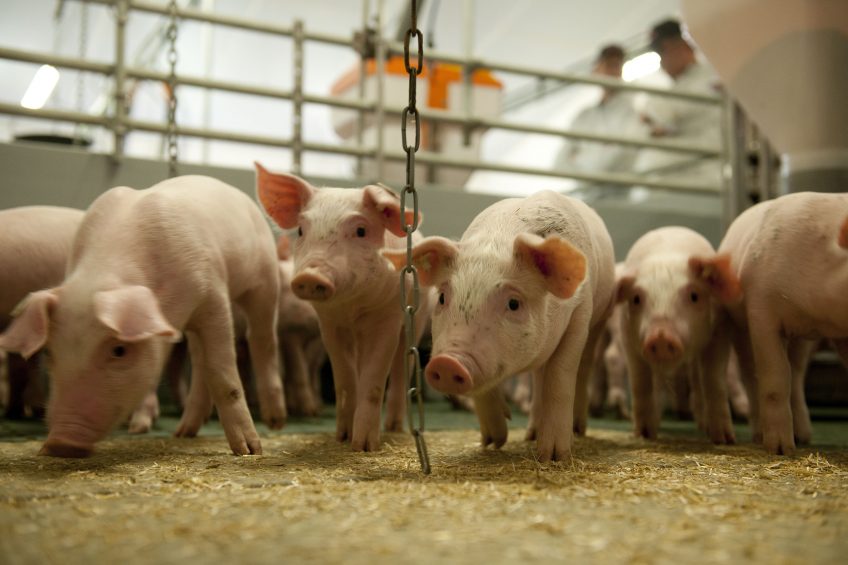Gut integrity, intestinal microbiota and intestinal barrier

The gut carries an important responsibility in selecting what can be absorbed and what should remain outside the body. To put this in the right perspective, it is important to note that the surface of the intestinal tract is 300 times the size of the surface of the skin.
Post-weaning diarrhoea (PWD) causes mortality and morbidity in pig production and is a reason for regular antibiotic treatment. 2 concerns are related with PWD:
- Lost profit due to mortality, lower average daily weight gain (ADWG), additional medication costs.
- Recommendation of European Medicines Agency for reducing the usage of Col-istin related to the risk of antimicrobial resistance.
To reduce (stop) antibiotics for PWD and to enhance performance is crucial to under-stand and to support the complex mechanism that maintains the gut health. This trial in-vestigated the effectiveness of in feed combination of short and medium chain fatty acids, plant extracts and essential oils (Lumance, Innovad, Belgium) on PWD and ADWG in a commercial farm in Bulgaria.
Maintaining gut health
The gut integrity and microbiota appear to be the key for a mechanism that maintains the gut health. Supporting the intestinal barrier to decrease the risk of infectious and inflam-mation is crucial. Tight junctions have a major task to avoid paracellular passage of unde-sired substances from the lumen to the inside of the body.
Different factors could have a negative impact on the tight junctions, leading to “leaking gut” which resulting further in cell damage, production of “Reactive Oxygen Species” (ROS) and activation of the immune system. This automatically unlocks the production of inflammatory cytokines. Their neutralisation will consume significant amounts of nutri-ents, leading to reduced growth and increased FCR.
Epithelial cell proliferation stimulated
It is documented that butyrate enhances the intestinal barrier by facilitating tight junction assembly and regulating of immune cells function. Butyric acid contributed with plant ex-tracts rich alkaloids show strong anti-inflammatory action, improved gain and FCR. Butyr-ate stimulates epithelial cell proliferation ensuring larger absorptive surface and improved feed utilisation. It preserves villus length and its role at weaning is highly valuable when the intestine increases 3 times faster than the whole body mass.
Host defence peptides (HDPs) are a critical component of the innate immunity. Butyrate upregulates endogenous HDP and enhance disease resistance in piglets. It increases glutathione and so is indirectly active against ROS.
Strong antibacterial activity
Butyrate has strong antibacterial activity, but mono-esterified butyrins is several times stronger against E.coli and Salmonella compared to butyric acid. Combination of esteri-fied butyrins and medium chain fatty acids (capric) significantly improves the perfor-mance of the pigs and laurin is highly effective against E.coli, Salmonella sp. and Clos-tridium perfringens.
The broad spectrum of intestinal microbiota lives in direct symbiosis with the host. They provide energy to the intestinal wall, prevent colonisation by pathogenic bacteria and help to maintain the intestinal immune system.
Materials and Methods
In 2 trials (T1 and T2), a treatment of 400 piglets each, was compared with a control group of 400 piglets. The treatments in T1 and T2 included Lumance at respectively 1,5 kg/T and 1 kg/T in the feed from the day of weaning (30 days) for 20 days and ZnO for 20 days 3000 ppm and 2000 ppm respectively starting from weaning. The control group for both trials included Colistin (12% ) in the feed at 2 kg/T for 10 days from weaning and ZnO, 3000 ppm for 20 days from weaning. PWD and ADWG were monitored from D30 until D94.
No symptoms of PWD were observed in none of the groups during both trials. ADWG in growing phase were respectively: control groups – 610 g and 620 g and Lumance® groups – 675 g in T1 and 709 g (Figure 1). At the end groups T1 and T2 shows 7 days earlier to slaughter (150 days) at an average weight of 107 kg.
Reducing the level of inflammatory cytokines
Based on the above, we can conclude that a high status of intestinal health based on a combination of strong tight junctions, long and healthy villi, balanced the microflora, low levels of ROS and inflammatory cytokines ensure the possibility to stop antibiotic treat-ments and improving the performance. Complex formula of Lumance is an effective to replace Colistin and reduce ZnO for preventing PWD, while having a positive effect on ADWG of the treated animals.











